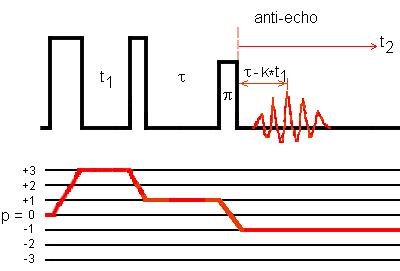
Phase-modulated shifted-echo pulse program for 3QMAS and I > 3/2.
Contribution of R. Hajjar

Below NMR pulse program describes:
(1) either the phase-modulated shifted-echo for (1D and 2D) +3Q-MAS experiment applied to quadrupolar nuclei with half-integer spin I > 3/2;
(2) or the phase-modulated shifted-antiecho for (1D and 2D) +3Q-MAS experiment applied to quadrupolar nuclei with I = 3/2 (see figure).
The phase cycling for the third pulse and the receiver is shorter than that in the 3-strong pulse sequence. However, there is no harm in applying the phase cycling of the 3-strong pulse sequence when the third pulse is a selective pulse.
In practice, mainly the first application is considered in 2D experiments.
This NMR pulse program is for Bruker Avance spectrometers.
After the Fourier transform with respect to t2, a tau-dependent first-order phase correction is performed to remove the phase modulation due to the shift and a t1-dependent first-order phase correction to perform the shearing transformation.
; RHmp3qShiftAEsel ; 3Q MAS pulse program for nuclei with half-integer quadrupole spin, ; phase-modulated shifted-antiecho for I = 3/2, ; or phase-modulated shifted-echo for I = 5/2 and higher, ; 3-pulse experiment with full echo acquisition: ; excitation(3Q) - conversion(1Q) - tau - 180sel - acquisition(-1Q), ; 180° selective pulse should be determined first using Hahn-echo, ; this way also be used to check that full echo can be obtained ; from sample of interest. ; If no full echo can be obtained from sample, use mp3qzfil instead, ; then optimise p2 and finally pl, 2 or more iterations for pl and p2 ; may be necessary. ;ns : 48*n ;d1 : recycle delay ;p1 : excitation pulse at pl11 ;p2 : conversion pulse at pl11 ;p4 : 180 degree selective pulse at pl21 ;cnst31 : MAS spin rate ;pl1 : = 120 db ;pl11 : power level for excitation and conversion pulse ;pl21 : power level for sélective pulse, ca. Pl11 + 30 dB ;d6 : to allow full echo to build up ;l1 : number of rotor cycles for whole echo ;d0 : = 3u or longer ;in0 : 1 rotor period for synchronised experiment ;td1 : number of t1-experiments ;FnMODE : QF ;MC2 : QF "d6=((1s*l1)/cnst31)-(p2/2)-(p4/2)" ; set the delay d6 according to l1 and cnst31 ; values by the spectrometer automatically, ze ; clear memory, new data replace old data, ; switch AD converter to replace mode, ; perform DS before next acquisition, 1 d1 ; recycle delay, 10u pl11:f1 ; 10 microsecond delay, ; set high power in f1 channel, (p1 ph1):f1 ; high-power excitation pulse, d0 ; delay between pulses, t1 increment, (p2 ph2):f1 ; high-power conversion pulse, d6 ; delay tau calculated automatically, (p4 pl21 ph3):f1 ; set low power in f1 channel, ; 180° selective pulse, go=1 ph31 ; signal acquisition, ; loop to 1, NS times for averaging, d1 mc #0 to 1 F1QF(id0) ; delay for disk I/O, store signal, ; increase FID number, ; delete memory data, ; do not perform dummy scans ; with next acquisition, ; increment time d0 by in0, exit ; end of the pulse program ph1=(12) 0 1 2 3 4 5 6 7 8 9 10 11 ; excitation pulse phase ph2= 0 ; conversion pulse phase ph3=(4) 0 0 0 0 0 0 0 0 0 0 0 0 1 1 1 1 1 1 1 1 1 1 1 1 2 2 2 2 2 2 2 2 2 2 2 2 3 3 3 3 3 3 3 3 3 3 3 3 ; 180° selective pulse phase ph0= 0 ph31= 0 3 2 1 0 3 2 1 0 3 2 1 2 1 0 3 2 1 0 3 2 1 0 3 ; receiver phase